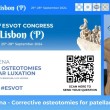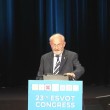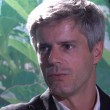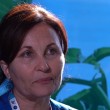Uli Matis
Dr.med.vet. Dr.med.vet.habil., Dipl.ECVS
Former Professor of Surgery and Head of the Department of Surgery Faculty of Veterinary Medicine
Ludwig-Maximilians-University Munich, Germany
Please insert your career since graduating to date
UM. I often think that my career started when I was still an undergraduate student because of my fascination with surgery. After graduation from the veterinary school at the Ludwig-Maximilians University (LMU) in 1971, I was enrolled as an intern and soon after as a resident at the Clinic of Veterinary Surgery at LMU under the guidance of Professor Dr. Dr. h.c. Horst Schebitz. In 1973, I received the Dr.med.vet degree (summa cum laude) for a dissertation that examined experimentally lyophylized dura mater grafts as a substitute for the anterior cruciate ligament in dogs. In 1981, I completed a Dr.med.vet.habil. degree for research in the field of intraoperative haemostasis. During this work, I spent almost two years in human medical research institutions. In 1975, I earned the German Diploma of Veterinary Surgery, in 1988 the German Diploma of Veterinary Radiology and in 1997, I became a Diplomate of the European College of Veterinary Surgeons.
With the exception of a few guest appointments at other universities, my academic career evolved in Munich; I started as an associate professor of surgery in 1982 and in 1989, became the Chair of Veterinary Surgery (including anaesthesia, ophthalmology and radiology) and director of the Clinic of Veterinary Surgery at LMU. At that time, the clinic included horses and cattle as well as companion animals. This commitment was preceded by several attractive offers from other universities including a visiting professorship in 1983 at the Clinical Sciences Department, College of Veterinary Medicine, Ohio State University, Chair of Small Animal Surgery and Medicine, Free University of Berlin, Germany, in 1986 and Chair of Veterinary Surgery and director of the Clinic of Veterinary Surgery, Faculty of Veterinary Medicine, University of Zurich, Switzerland in 1988. I had to decline these offers for personal reasons. At my retirement in 2011, I was able to look back upon a full 40 years of work at my alma mater.
G.S.-S. can you recall when you decided to become a veterinarian and did anyone in particular influence that choice?
U.M. As far back as I can remember I wanted to be a veterinarian. Although my parents thought that human medicine would be a better career choice for me - they even encouraged me and offered support to study human medicine after veterinary medicine – they accepted my decision. Dogs and cats were part of our family and I was an avid rider during my teenage years. There were two main reasons why I was drawn to small animal surgery rather than equine surgery: the wide range of fascinating treatment options available for companion animals and the generous support that I received in my professional endeavours from my teacher and mentor Professor Schebitz. It was my father who introduced me to the world of science and taught me critical thinking, and I am sure that his scientific enthusiasm was instrumental in forging my career. Finally, I owe a great deal to my colleague and husband Professor Köstlin, who has encouraged and supported me both personally and professionally since 1972.
G.S.-S. What led you to become interested in orthopaedics?
U.M. When I was 13 years old, the horse I was riding fell while navigating a jump and I suffered an open femoral fracture, which required bed rest for three months. I think this piqued my interest in osteosynthesis later in life. Orthopaedics including osteosynthesis has always been a main focus at the Munich school. Professor Schebitz championed osteosynthesis and habilitated in this field in the 1940s. He encouraged his students to explore and use modern surgical techniques. At that time, the surgical case load at the university clinic was enormous because there were not many specialised private clinics, and therefore young aspiring surgeons had ample opportunity to operate, gather scientific data and publish clinical research papers. After completion of my habilitation in 1982 and with the full support of Professor Schebitz, I spent several weeks in the USA learning how to perform total hip replacement, which at the time was a special interest of mine. Both Drs William Jackson and Walter Sokolowski referred me to Professor Bruce Hohn at the Ohio State University, who not only introduced me to the technique of total hip replacement but also invited me as a speaker and instructor to the AO ASIF courses that he organised. I was very fortunate to meet many international leaders in veterinary orthopaedics, to become familiar with the latest surgical techniques and to forge friendships that lasted my entire professional career. The latter allowed me to provide international contacts to my own students. I am particularly thankful to Professor Hohn for his help with establishing a structured residency system at the Munich Veterinary School, similar to the one he introduced in the USA.
G.S.-S.Is there a piece of research of which you are particularly proud?
I don’t know whether there was one piece of research that I was particularly proud of, but there were many that made me extremely happy. It was satisfying to see novel findings, techniques and developments published in dissertations or in German-language journals subsequently revisited and confirmed by international investigators. It was also rewarding that Munich was the venue of the annual conference of the European Society of Veterinary Orthopaedics and Traumatology, and that we, together with the Veterinary Orthopaedic Society, were able to host the first World Veterinary Orthopaedic congress. To be trusted with serving as president of three international associations (AO Vet International, 1996 to 1998; European Society of Veterinary Orthopaedics and Traumatology, 1998 to 2000; European College of Veterinary Surgeons, 2005 to 2006) was a great honour and an unexpected recognition of my work, as was the World Small Animal Veterinary Association Saki Paatsama Award in 2001. Saki’s world famous thesis was the first scientific publication that I studied intensively during the course of my own dissertation. I was very fortunate to have known Saki and to be a friend of his until his passing in 1998. It is not a matter of pride but it makes me very happy to have had and still have personal and professional contact with many colleagues that shape the world literature on companion animal surgery.
















